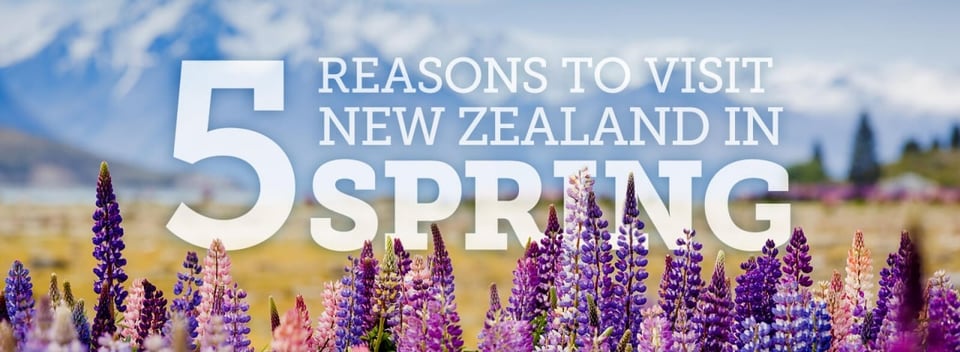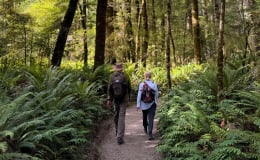
5 Reasons to Visit During Spring in New Zealand
Spring in New Zealand: September - November.
Spring in New Zealand officially runs from September through November. During spring, our beautiful landscape bursts into life, with vibrant dashes of colour from the wild lupins and newborn lambs playing in the fields. Here at New Zealand Trails, Spring is one of our favourite times to explore New Zealand and a great time of year to plan your visit. Temperatures are beginning to heat up and with the last remnants of snow still lingering on the mountain peaks it's hard not to love New Zealand in Spring. Average temperatures during the day range from 10°C (50°F) to 21°C (70°F) depending on which island you're visiting, making it a comfortable climate to be out exploring.
Here are 5 reasons why travelling to New Zealand in spring is a great idea.
Spring is our favourite season! It’s an incredibly uplifting time of year having said goodbye to winter. New life abounds and the promise of warm days and great weather to have some outdoor adventures is now a reality. For our guides, it’s a really exciting time as they’re fresh from their winter hibernation and are raring to go for the new season!
It can be a great time to visit New Zealand for several reasons. It's kind of a locals' secret – particularly in the South Island – that spring offers some of the best walking and travelling around the country. The weather is not too hot so you won't overheat exercising outdoors, and there are often remnants of the winter's snow still visible on the mountain peaks which makes for some very pretty scenery.
Anyone who’s visited us down here in New Zealand will know that the weather doesn’t pay attention to any rules either – so the trick is to be prepared. It tends to be pretty comfortable in the daytime; you might need a long-sleeved jacket or sweater but usually nothing more. Mornings may be a little chillier, perfect for that New Zealand made merino wool sweater you’ve just picked up! Layering is always a good idea and hopefully by midday you might feel like stripping down to a t-shirt.
Temperatures in spring vary between the North and South Islands of New Zealand. Overall, though it’s mild from October through to November, it’s typically a little warmer up in the North Island than further south. With an average daytime temperature ranging between 17-21°C (62-70°F) and warming up even more as summer approaches, conditions are ideal for exploring. Imagine kayaking the turquoise waters of Cathedral Cove or hiking a trail past emerald mountain lakes on the Tongariro Crossing (we visit here on our Sweet North trip)!
Down in the South Island, you can expect slightly cooler starts in the morning with the odd frost here and there. Once the sun’s up, temperatures usually sit between 10-18°C (55-65°F) during the day in most places. With summer just around the corner as we head into November, temperatures tend to settle around the low 20s (70°F). You’d be more than comfortable hiking the Routeburn Track through ancient beech forests and alongside crystal-clear alpine streams in a light jacket and shorts. The sun’s very strong here, so don’t forget to put on your sunscreen.
Check out the infographic below for some weather averages. Weather during spring in New Zealand can be fickle though, so you could encounter all sorts on any given day! But that often adds to the drama of the landscape and allows you to see our country in all of its colours. Read on to find out our top five reasons why spring is one of our favourite times of the year to explore New Zealand.

*Weather data is based on Christchurch, half way up the South Island. Expect regional variation.
1. New Zealand spring flowers
The inimitable Robin Williams said that “spring is nature’s way of saying, ‘let’s party!’” And we reckon New Zealand’s diverse array of plant life would have to agree. Wildflowers are blooming, fresh green grasses are sprouting, deciduous trees are waking up from their winter hibernation and there’s a real feeling of new life all around. It really is plant party time!
If it’s the plant kingdom which captivates you then New Zealand will be paradise – spring is the time our natives start blooming and many flowers have completely gone by summertime, making October and November the best months. There are literally thousands of types of flowers here in New Zealand, many of which you will have never seen before. Our springtime favourites are the Mount Cook Lily, Greenhood Orchids and New Zealand Tree Fuchsia.
One of the most photographed of all our wildflowers during spring would have to be the lupin. An introduced species with a somewhat controversial history, it flowers from November onwards. You’ll see vast fields of pink, purple, blue and white blooms stretching on to the horizon line. Framed by a background of snow-capped mountain peaks and lush forests, it truly is an impressive sight.
Of course, during New Zealand spring you’ll always find cheerful rows of daffodils popping their heads up, but we also have a vast array of native trees, plants, flowers, shrubs, ferns and mosses, many of which gain a new ‘spring’ in their step after winter. Our unofficial national flower, the native Kowhai also blooms during the spring months – its brilliant bright yellow flowers attracting all manner of little birds such as the fantail, tui and bellbird. From October onwards, the endemic Harakeke (flax) also puts out large orange-red flowers which really get the native birds excited!
80% of our tree and plant life is found only in New Zealand and with our expert local guides to show you the best spots to soak it all in, plus the gorgeous spring weather to complement the experience, you’re bound to enjoy yourself.
2. Wildlife up close and personal
This is the time of year our friends in the animal kingdom are welcoming their young into the world and they’re there for us to see. On our spring trips we're regularly delighted by the sights of baby fur seals on the Fiordland Coast, penguins returning to their nests after a day’s‘work’ out fishing in the ocean and sharing our walking tracks with families of native birds.
You can’t speak about spring in New Zealand without mentioning lambs, it would be a crime. We know they’re not wild, but they’re too adorable to ignore. New Zealand is famous for its population of sheep, providing us with not only the superbly practical merino wool but also a tasty Sunday roast option (lambs, cover your ears!) Aside from those uses, they are also a tremendous source of entertainment, particularly during lambing season. From early September onwards, you’ll start to notice teeny bundles of fun in lamb form appearing like popcorn in fields right up and down the country. You can’t help but laugh as you watch them charging up and down together, frolicking around before collapsing on the sweet grass for a well-deserved nap in the sun. If you join us on our Masterpiece tour during spring, you might even get a chance to bottle feed one of these joyous little creatures at Mt Nicholas Station, a working high country farm.
Enough about lambs though, we all know they’re cute. What other wildlife can you hope to see during a New Zealand spring? New Zealand is home to over 40 endemic birds, including the iconic kiwi, cheeky kea and curious kakapo. Whilst it’s possible to spot these birds year-round, often the first flush of spring growth means they’re livelier during this time. Chicks are hatching, so hard-working parents are busy collecting food and you’re more likely to spot them in action. Of course, this means that our busy birds deserve peace and ample space from us, but you’ll find that the places we visit on our trips allow for that in a natural and tranquil setting. Okarito Lagoon is one of the best spots in New Zealand for viewing birdlife in its natural habitat. Gliding along silently in comfortable kayaks with the sun glistening on the calm waters, there’s no better chance to politely observe the rare kotuku (white heron) or one of the other 70 species making their home in and around Okarito.
The New Zealand fur seal is another creature you’ll meet during spring, basking in the sun and resting before their pups arrive around mid-November. Once hunted to point of extinction by early European settlers, their numbers are now stable and gradually increasing, which means we can happily observe them in all their blubbery glory. Join us on our World Heritage trip for a once in a lifetime experience as we helicopter to remote Martins Bay in Fiordland National Park to meet the resident colony of fur seals. And what better time than spring to witness them at home in the water and relaxing on the rocks.

Fiordland Crested Penguins preening themselves in the New Zealand spring sunlight.
3. Don't go chasing waterfalls
New Zealand is a country of waterfalls, from the most intricate and delicate trickles to the raw unleashed power of mother nature. With the snow-melt after winter, spring is 'waterfall season' and you’ll be in awe of the waterfalls in and around the glacial valleys of the Southern Alps. Where is our favourite place for waterfalls? From the towering falls of Milford Sound, the sheer force of Giant’s Gate Falls on the Milford Track to the picture-postcard of Little Homer Falls on the Hollyford Track – Fiordland is waterfall heaven.
New Zealand boasts a variety of stunning natural waterfalls from north to south, so you’re never too far from the sound of cascading water. During the spring months, these tumbling towers of clear water are at their finest. With snowmelt from the mountain peaks and a little additional rainfall, you’ll be astounded at the thundering falls and powerful torrents of water during spring.
Fiordland National Park, and Milford Sound, in particular, is home to some of our most impressive waterfalls. The tallest and arguably most spectacular is Bowen Falls, dropping some 162 metres to the sea and providing Milford’s small settlement with its power and water source. The second tallest is Stirling Falls at 151 metres in height. It’s best viewed from the deck of a boat which will take you close enough to feel the spray on your face - an experience you won’t forget on our Pure South trip.

Milford Sound is home to some of the best waterfalls anywhere in New Zealand.
4. Get a great deal on your airfare
If you’re coming to New Zealand in October and November, great news! This is the time of year the airlines want you on their planes and will have deals running. High season in New Zealand is from the end of December through to February but the spring months are ‘shoulder season’ and therefore the best time to find a great airfare. Many airlines' websites have a feature where you can save a destination and get alerts when there is a price drop or a special offer. It's worth signing up to take advantage of those great savings. If you'd like to take the research and stress out of booking flights, just make it easy on yourself and talk to our experienced team who are happy to help.

5. Quieter trails and fewer ‘tourist hotspots’
Again, because spring is traditionally a 'shoulder season', our world-famous Great Walks, national parks and all the other great trails around the country have yet to hit their peak visitor numbers. Not that our trails are ever crowded, but there are definitely fewer people around in general. So if you're the kind of person that likes a trail to themselves (or at least to feel like that!) then October and November are the perfect months for you. Aside from the abundance of natural delights that spring brings with it, there are also a few unexpected perks to travelling to our shores from October through November, into early December. While some in the travel industry might consider spring to be the shoulder season, not so at New Zealand Trails - we love it!
New Zealand is not a crowded place, even during the height of summer there’s always a quiet spot to enjoy the views. But during the spring months, before the kiddies are on their summer holidays and most selfie-stick wielding tourists arrive, you’ll quite often get the pristine tracks and trails all to yourself. What could be better than marvelling at a majestic mountain view in the company of a small group of like-minded travellers, without another soul around for miles – bliss if you ask us! Out on the trail, the only sounds you’re likely to hear are the breeze in the trees, the call of a forest bird or the rushing of a trackside stream. We can’t guarantee complete isolation (you’d have to head to Stewart Island for that) but you’ll find spring hiking in New Zealand will be a lot quieter than a high summer adventure.
Spring hiking in New Zealand
Hopefully, after reading this post, you’ll have a good understanding of why the team at New Zealand Trails are so passionate about our little country and especially so during spring. As a band of happy kiwis, we’re typically even cheerier during the spring months! That’s not to say that if you come to New Zealand any other time, we won’t be as friendly, it’s just you might notice a little extra pep in our step from October onwards. For those of you that can’t make it down here during spring, all is not lost. You’ll still have an incredible time no matter when you come, we promise.
Our season kicks off every spring and our seven, fully-guided small-group tours set off around this beautiful country again. So whether you are looking for the comfort and restaurant dining offered on our 14-day Grand Explorer, or the Masterpiece's mix of activity and relaxation, the more challenging Kiwi Classic, the Pure South for those shorter on time or the taste of the North Island offered by the Sweet North – we're sure to have something perfect for you. If you're not sure you can check out our which trip is right for me page or, of course, you can just ask us any time.







